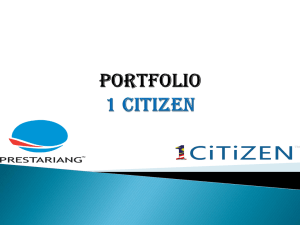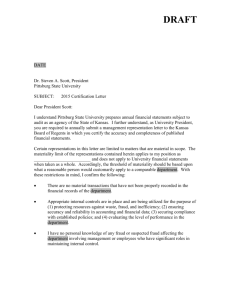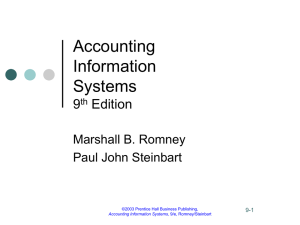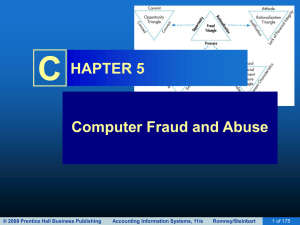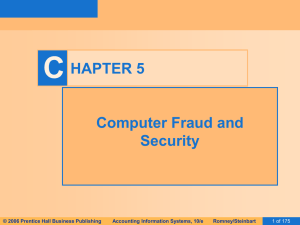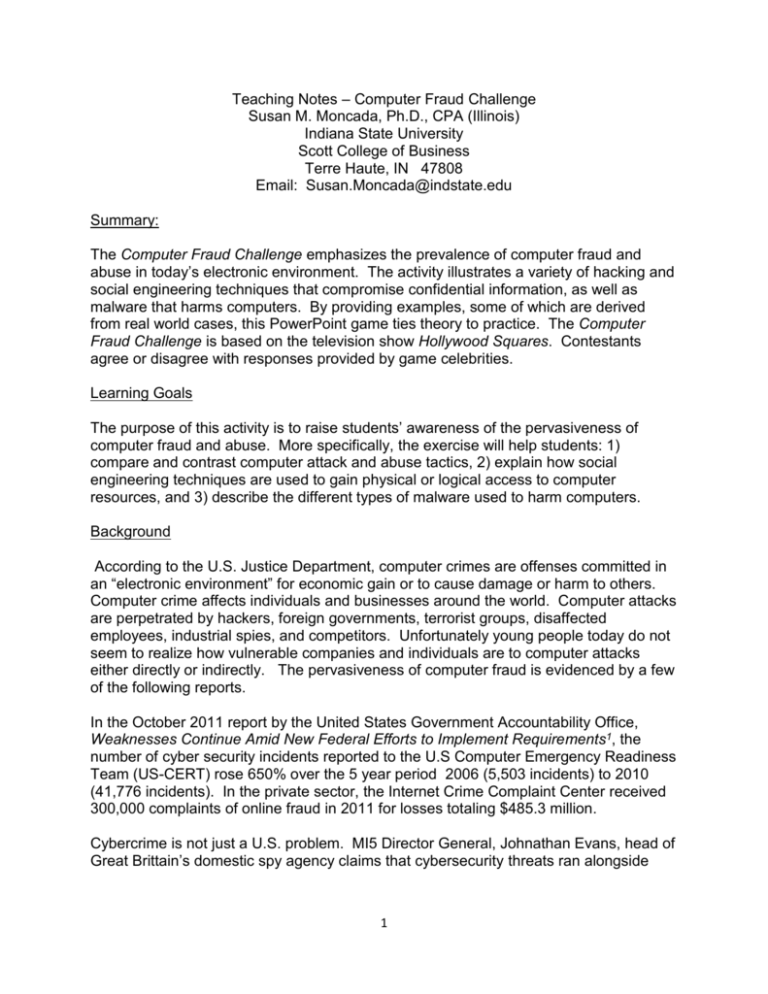
Teaching Notes – Computer Fraud Challenge
Susan M. Moncada, Ph.D., CPA (Illinois)
Indiana State University
Scott College of Business
Terre Haute, IN 47808
Email: Susan.Moncada@indstate.edu
Summary:
The Computer Fraud Challenge emphasizes the prevalence of computer fraud and
abuse in today’s electronic environment. The activity illustrates a variety of hacking and
social engineering techniques that compromise confidential information, as well as
malware that harms computers. By providing examples, some of which are derived
from real world cases, this PowerPoint game ties theory to practice. The Computer
Fraud Challenge is based on the television show Hollywood Squares. Contestants
agree or disagree with responses provided by game celebrities.
Learning Goals
The purpose of this activity is to raise students’ awareness of the pervasiveness of
computer fraud and abuse. More specifically, the exercise will help students: 1)
compare and contrast computer attack and abuse tactics, 2) explain how social
engineering techniques are used to gain physical or logical access to computer
resources, and 3) describe the different types of malware used to harm computers.
Background
According to the U.S. Justice Department, computer crimes are offenses committed in
an “electronic environment” for economic gain or to cause damage or harm to others.
Computer crime affects individuals and businesses around the world. Computer attacks
are perpetrated by hackers, foreign governments, terrorist groups, disaffected
employees, industrial spies, and competitors. Unfortunately young people today do not
seem to realize how vulnerable companies and individuals are to computer attacks
either directly or indirectly. The pervasiveness of computer fraud is evidenced by a few
of the following reports.
In the October 2011 report by the United States Government Accountability Office,
Weaknesses Continue Amid New Federal Efforts to Implement Requirements1, the
number of cyber security incidents reported to the U.S Computer Emergency Readiness
Team (US-CERT) rose 650% over the 5 year period 2006 (5,503 incidents) to 2010
(41,776 incidents). In the private sector, the Internet Crime Complaint Center received
300,000 complaints of online fraud in 2011 for losses totaling $485.3 million.
Cybercrime is not just a U.S. problem. MI5 Director General, Johnathan Evans, head of
Great Brittain’s domestic spy agency claims that cybersecurity threats ran alongside
1
terrorism as one of the country’s most pressing security challenges. In just one recent
case, a company incurred $1.2 billion in losses from a cyber attack.2
Due to the proliferation of cyber crime faced by corporate America, in October of 2011,
the SEC issued informal disclosure guidance asking public companies to voluntarily
report cyber security risks and incidents in their annual reports. Companies, however,
are not voluntarily complying in fear of damage to their public image which could lead to
stock price declines and investor lawsuits. Some recent corporate victims include
Wyndham Worldwide Corp, Verizon, Epsilon (a division of Alliance Data Systems) and
LinkedIn. Thousands of customers’ had personal information compromised. In
response to the lack of corporate compliance, as of June 2012, the SEC announced it is
adding a provision to its cyber security legislation to strengthen compliance
requirements.
__________________________________________
1Highlight
of GAO-12-137, a report to congressional committees. Retrieved on July 12, 2012 from
http://www.gao.gov/assets/590/585570.pdf
2Associated
Press, June 29,2012, Cybercrime Disclosures Rare Despite New SEC Rule, retrieved from
http://accounting.smartpros.com/x73914.xml, SmatrPros, July 11, 2012.
Context for Use
The Computer Fraud Challenge is an informal formative assessment activity to be used
after students have studied computer fraud and abuse conducted in today’s technology
environment. The activity was designed specifically to supplement Chapter 6 of the
Romney & Steinbart, 12e, Accounting Information Systems text.
1. This PowerPoint game can be played in class by having students divide into two
teams with the instructor serving as the moderator.
2. If students bring their laptops to class, the game can be played in drill and
practice pairs.
3. In the online environment, the game can be played during an Eliminate Live
session.
4. The game can also be played individually outside of class time as a form of drill
and practice.
Prerequisite Knowledge
Familiarity with computer fraud and abuse techniques from course readings or
class lecture.
Teaching materials
Game 1 (27 scenarios)
Game 2 (27 different scenarios with correct response locations varied).
2
Solution Keys for Game 1 & Game 2. The keys include explanations for the correct
response when a character provides an incorrect answer.
Teaching notes (printable version of the text on the website with additional tips)
Teaching Notes
These PowerPoint games were designed with Office 2007. They are fully
compatible with Office 2010. Playing instructions are included within the PowerPoint
slides.
The 27 scenarios included in each game represent a small sample of computer
frauds perpetrated. After each scenario is covered, the instructor should review the
key aspects of the particular type of computer fraud.
I let students use their laptop computers to search for answers. Of course, they
usually cannot find verbatim definitions or examples. Having references available
helps generate discussion as teams try to determine the correct response .
For each incorrect response provided by a celebrity, an explanation of that particular
fraud should be provided as well. Students will want to know the difference. Some
of the incorrect answers are purely fictitious terms or phrases.
On repeat plays, I was also pleasantly surprised to see students intentionally
seeking questions from characters they hadn’t previously selected. They became
more interested in learning than winning the game.
Resources
Romney, M.B., & Steinbart, P. J. (2012) Accounting Information Systems (Chapter 6,
pp. 148-167), 12ed., New Jersey: Pearson Prentice Hall.
3


